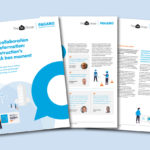The Future of Construction — an initiative run by framework provider Pagabo and its parent company The 55 Group — has published a white paper that gives unique insight from industry leaders on the biggest challenges the sector currently faces. It crucially reveals a shared opinion that the sector faces a serious decline and stagnation without collaboration.
The ‘Collaboration Transformation’ paper details the findings of an in-depth survey with 55 industry leaders, from companies across the industry, with workforces ranging from 50 to 2,500. The results and opinion place a particular focus on the widening skills gap, and how little to nothing of actionable difference is being done to attract and retain the best talent and make training truly fit-for-purpose.
 Gerard Toplass, Group CEO at The 55 Group, said: “Structural changes in the labour market from factors like Brexit, Covid, and the changing motivations of workers are all making recruitment tough, but for 92% of firms within the construction industry reporting this it poses a real risk to the sector at large.
Gerard Toplass, Group CEO at The 55 Group, said: “Structural changes in the labour market from factors like Brexit, Covid, and the changing motivations of workers are all making recruitment tough, but for 92% of firms within the construction industry reporting this it poses a real risk to the sector at large.
“Construction is suffering similar problems to other sectors, but those other industries are better focused on training and realise the importance of improved education and practical training. And most importantly, other industries are making sure their training keeps pace with innovation.
“Meanwhile, we believe that construction is heading towards a cliff edge — especially when it comes to adapting the approach to skills and training. A large proportion of workers are within 10 years of retirement age, so what is going to happen if we don’t backfill these roles? And what happens if we don’t successfully plug the skills gap?
“The simple answer is that the industry will grind to a halt. It is crucial that we work to change the approach to training to ensure we attract both the people needed to tackle modern issues — and deliver the key skills in a better way — to make sure this does not happen.
“Qualifications need to be shorter, punchier, and aligned to the changing needs of the sector, as well as those of the individuals expected to learn. Training in construction is simply not keeping up with the pace of change, which is seeing increased digitisation and innovation, and a drive to meet net zero carbon.”
The 55 Group has backed up this call to arms for short-duration training through its partnership with ProQual, which saw the creation of the ProQual Level 2 Award in Rainscreen Cladding Installation qualification. Upon completing 80 guided hours, learners are considered competent to do this role – helping to plug a gap in this specific skills area much more quickly than the current 680-hour NVQ course.
Gerard said: “While the course has been deemed the right level and timescale to meet the competency requirements and learners being qualified, a lack of integration with industry bodies means the course is not able to be aligned to a CSCS card. This means that works are unable to operate unsupervised even with their new skills unless they already hold a card.
“This is a clear pitfall and shows why we need industry bodies to operate at pace with a more external attitude. This course was developed in response to the desperate need for more cladders post-Grenfell, yet even when people can be trained competently and quickly there are still barriers to access.”
Lord Bob Kerslake, Group Strategic Adviser to The 55 Group and former head of the civil service has backed the white paper’s findings. He said: “The skills gap issue threatens to be a major barrier on delivery in construction and is a major barrier to growth. As an industry, we must understand what we can do together to tackle these major challenges.
“We are at a pivotal moment — and we urgently need to address the need for cross-industry data sharing and a combined approach to the skills gap, both of which present the biggest challenges to development and growth.
“This white paper gives a very valuable contribution to the debate, and I hope that people within the industry consider it — as well as the relevant people in government.”
The white paper also details the need for the construction sector’s ‘black box moment’, taking inspiration from how the black box transformed the aviation industry and generated a complete reset within the sector. This breakthrough will require what aviation achieved — creating a heart culture driven by learning over blame and making incremental gains and continuous improvement.
The survey found that a ‘black box for construction’ — or in this case a central digital platform based on the principle of data-sharing — was the route forward, with 84% backing the idea. The intention is to create this platform, which is to be a cloud-based system and will be underpinned by a community that will work together as one, prompting better efficiency, safety and sustainability — and promote the sector as a desirable career outlet.
 Charley Wainwright, Head of Innovation at Pagabo who carried out the one-to-one surveys, said: “Taking inspiration from the impact the invention of the black box had on aviation, we want to inspire a complete industry transformation. We want to take us to a culture of sharing and true collaboration and remove siloed efforts and any semblance of a blame culture — which is something many surveyed noted about the culture around health and safety.
Charley Wainwright, Head of Innovation at Pagabo who carried out the one-to-one surveys, said: “Taking inspiration from the impact the invention of the black box had on aviation, we want to inspire a complete industry transformation. We want to take us to a culture of sharing and true collaboration and remove siloed efforts and any semblance of a blame culture — which is something many surveyed noted about the culture around health and safety.
“This survey and white paper have been illuminating — and certainly not all doom and gloom. There is a clear pride that comes through regarding what the UK’s construction industry has and is capable of achieving, along with a clear determination to steer us away from the metaphorical cliff edge. The time is here to seize the opportunity before us and start effecting real and long-lasting change.”
To learn more, please read The Collaboration Transformation white paper by visiting https://pagabo.co.uk/storage/uploads/collaboration/the-collaboration-transformation.pdf










